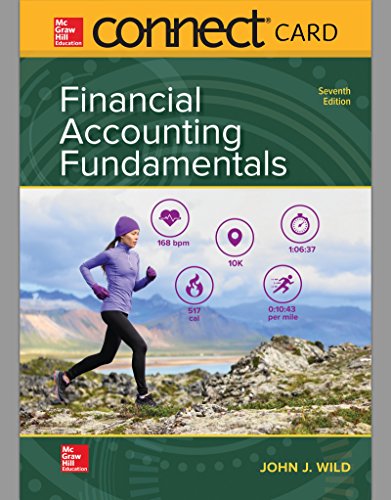
1.
Prepare the
1.
Explanation of Solution
Bonds: Bonds are long-term promissory notes that are represented by a company while borrowing money from investors to raise fund for financing the operations.
Bonds Payable: Bonds payable are referred to long-term debts of the business, issued to various lenders known as bondholders, generally in multiples of $1,000 per bond, to raise fund for financing the operations.
Prepare journal entry for issuance of bonds payable on January 1, 2017.
| Date | Account Title and Explanation | Post Ref | Debit ($) | Credit ($) | |||
| 2017 | Cash | 292,181 | |||||
| January 1 | Discount on Bonds Payable | 32,819 (1) | |||||
| Bonds Payable | 325,000 | ||||||
| (To record issuance of bonds payable at discount) | |||||||
Table (1)
Working Note:
Calculate the amount of total bonds discount.
Par
Issue price of bonds = $292,181
Description:
- Cash is an asset and it is increased. So, debit it by $292,181.
- Discount on Bonds Payable is an adjunct liability account and it is decreased. So, debit it by $32,819.
- Bonds payable is a liability and it is increased. So, credit it by $325,000.
2.
Calculate the total bond interest expense that will be recognized over the life of the bonds.
2.
Explanation of Solution
Calculate the total bond interest expense.
| Details | Amount ($) |
| Total interest payments for 4 years (8 Semiannual payments) | 65,000 (2) |
| Add: Discounts | 32,819 (1) |
| Total bond interest expense | 97,819 |
Table (2)
Working Note:
Calculate the total interest payments for 4 years (semi-annually).
Therefore the total interest payment for 4 years (semi-annually) is $97,819.
3.
Prepare an amortization table for the first two years of the bonds using straight-line method to amortize the discount.
3.
Explanation of Solution
Prepare an amortization table for the first two years of the bonds using straight-line method to amortize the discount.
| Date | Discount Unamortized ($) | Carrying Amount ($) |
| 01/01/2017 | 32,819 | 292,181 |
| 30/06/2017 | 28,717 | 296,283 |
| 31/12/2017 | 24,615 | 300,385 |
| 30/06/2018 | 20,513 | 304,487 |
| 31/12/2018 | 16,411 | 308,589 |
Table (3)
Note: The amortization of bond discount per interest payment is $4,102 (3).
Working Note:
Calculate amortization of bond discount per interest payment.
Total bonds discount = $32,819 (1)
Number of semiannual payments = 8 (4 years semiannual payments)
4.
Prepare the journal entry to record semiannual interest and amortization of discount on bonds.
4.
Explanation of Solution
Prepare journal entry for payment of semiannual interest and amortization of discount on bonds.
| Date | Account Title and Explanation | Post Ref | Debit ($) | Credit ($) | |||
| 2017 | Bond Interest Expense (5) | 12,227 | |||||
| June | 30 | Discount on Bonds Payable (3) | 4,102 | ||||
| Cash (4) | 8,125 | ||||||
| (To record semiannual payment of interest and amortization of discount on bonds) | |||||||
Table (4)
Working notes:
Calculate the amount of cash interest paid (semiannually).
Par value of bonds = $325,000
Interest rate = 5%
Calculate the interest expense on the bond as on June 30, 2017.
- Interest expense is an expense and it decreases the equity value. So, debit it by $12,227.
- Discount on Bonds Payable is an adjunct liability account and it is increased. So, credit it by $4,102.
- Cash is an asset and it is decreased. So, credit it by $8,125.
Prepare journal entry for payment of semiannual interest and amortization of discount on bonds.
| Date | Account Title and Explanation | Post Ref | Debit ($) | Credit ($) | |||
| 2017 | Bond Interest Expense (6) | 12,227 | |||||
| December | 31 | Discount on Bonds Payable (3) | 4,102 | ||||
| Cash (4) | 8,125 | ||||||
| (To record semiannual payment of interest and amortization of discount on bonds) | |||||||
Table (5)
Working notes:
Calculate the interest expense on the bond as on December 31, 2017.
- Interest expense is an expense and it decreases the equity value. So, debit it by $12,227.
- Discount on Bonds Payable is an adjunct liability account and it is increased. So, credit it by $4,102.
- Cash is an asset and it is decreased. So, credit it by $8,125.
5.
Explain the changes on the amounts reported on the financial statements assuming the market rate on January 1, 2017 as 4% instead of 8%.
5.
Explanation of Solution
If the market rate on January 1, 2017 is 4% instead of 8% then the bonds must have issued at a premium as the contract rate of 5% is higher than the changed market rate of 4%.
Want to see more full solutions like this?
Chapter 10 Solutions
Connect Access Card For Financial Accounting Fundamentals

 AccountingAccountingISBN:9781337272094Author:WARREN, Carl S., Reeve, James M., Duchac, Jonathan E.Publisher:Cengage Learning,
AccountingAccountingISBN:9781337272094Author:WARREN, Carl S., Reeve, James M., Duchac, Jonathan E.Publisher:Cengage Learning, Accounting Information SystemsAccountingISBN:9781337619202Author:Hall, James A.Publisher:Cengage Learning,
Accounting Information SystemsAccountingISBN:9781337619202Author:Hall, James A.Publisher:Cengage Learning, Horngren's Cost Accounting: A Managerial Emphasis...AccountingISBN:9780134475585Author:Srikant M. Datar, Madhav V. RajanPublisher:PEARSON
Horngren's Cost Accounting: A Managerial Emphasis...AccountingISBN:9780134475585Author:Srikant M. Datar, Madhav V. RajanPublisher:PEARSON Intermediate AccountingAccountingISBN:9781259722660Author:J. David Spiceland, Mark W. Nelson, Wayne M ThomasPublisher:McGraw-Hill Education
Intermediate AccountingAccountingISBN:9781259722660Author:J. David Spiceland, Mark W. Nelson, Wayne M ThomasPublisher:McGraw-Hill Education Financial and Managerial AccountingAccountingISBN:9781259726705Author:John J Wild, Ken W. Shaw, Barbara Chiappetta Fundamental Accounting PrinciplesPublisher:McGraw-Hill Education
Financial and Managerial AccountingAccountingISBN:9781259726705Author:John J Wild, Ken W. Shaw, Barbara Chiappetta Fundamental Accounting PrinciplesPublisher:McGraw-Hill Education





